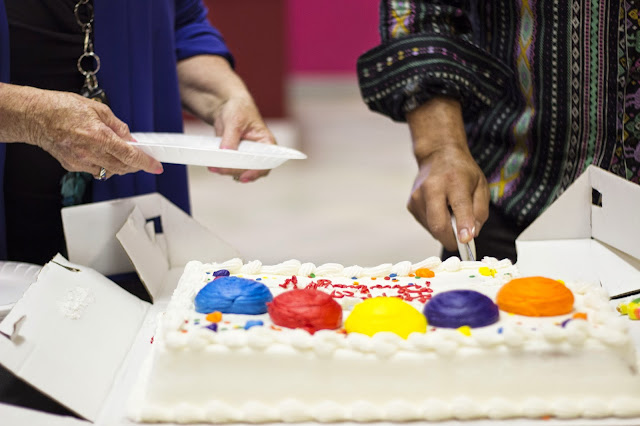The end of 2014 was so full and inspiring. We returned to the U.S., gave a workshop at a university, schemed about future plans, and held the first dance performance in a skirt made from migrants' clothes.
We were so honored and had so much FUN working with the wonderful people at Cal State Channel Islands (CSUCI) to put on a workshop for their students in conjunction with a campus visit by the remarkable author
Luis Alberto Urrea (who writes on growing up in Tijuana and is basically a stand-up comedian).
We got to see one of the skirts in action for the first time, as she was danced in by the student Ballet Folklorico group for the entire CSUCI campus. This skirt is one of
Las Dos Hermanas, two Mexican folk dance skirts made from migrants' clothing.

|
| Goyo Coyolicatzi Cortes, of the Ballet Folklorico de Channel Islands, performs in the "American Sister" falda. |
The student-led Ballet Folklorico de CI choreographed a dance for the
falda that featured 4 different regional styles of dance and costume from Mexico: from Sinaloa, Jalisco, and Veracruz. Such an amazing performance!
We also held a workshop at CSUCI. 30 students came together to discuss border crossings, the structural causes of immigration, and of course, to work with the clothes collected from migrants' trails in the desert.
In all of the Mending Patriotism workshops, the hope is to give people the chance to encounter a border. We sit together, we raise questions, and we tell our stories. Not everyone at first thinks they have a relationship with the border. For some -- who have never seen the US-Mexico border first-hand -- it is an opportunity to touch the physical evidence of the journeys that take place across the border and continue within the US.
At the CSUCI workshop, the students did some writing to reflect on how it felt to encounter these clothes. They touched on themes of human rights, being divided from family members, bafflement at how these clothes came to be where they were found, and messages of alliance & support.
Here are some excerpts from their responses to the prompt "Holding your clothes in my hands..."
***
Here I hold a beige bra. It looks like it has been in the desert for such a long time. Threads, holes, dirt and cuts all over it. This could belong to a mother, a sister, aunt. Who is dead or maybe alive nobody really knows. This drape left behind symbolizes a dream, a dream to make it to the land that would bring them a better future. Could this woman be a victim of rape? Why was her bra left behind? We don’t know but we do know that her biggest goal was to make it across the desert. This item symbolizes hope, courage, fear, strength, obstacles, sadness, crying, thirst, hunger, tiredness, feelings of being lost, it represents someone who hoped to one day find better opportunities, it represents a long journey that may or may not have been accomplished.
***
I wish I could take in your family of three
or do you even have children that will always be a mystery to me
I look at your green shirt
But where are you? Somewhere in the dirt?
You should be home after work
with your family not lost in the desert
Holding your clothes in my hand I am lost for words
***
Al tener su ropa en mis manos siento su amor, su desesperacion, su fuerza, sus ganas, y sobre todo siento su esperanza. Entiendo que su camino no ha sido nada facil, que esta decision no se tomo libremente, ni de un dia para otro. Talvez esta manana al partir de su casa, su esposa, su madre, su abuela o su hija fue la que le puso la bufanda. Talvez la bufanda la uso para proteger a su bebe. Quiero que sepa que sus motivos de cruzar, los que hayan sido no seran olvidados...y usted donde quiera que se encuentre no sera olvidada...la tierra que penetra la bufanda es nuestra de todo humano, no es mia, ni de el o de ella, es del universo. Este universo es de todos. Yo se que donde quiera que usted se encuentre a llegado a tener la felicidad que anela.
***
Looking down and seeing that tattered -- whatever it was-- a shirt, pants, handkerchief -- my stomach ached. It dropped so low I never thought I would get it back. The reds and whites of the cloth stood out to me like blood on a canvas. A canvas of your life. Your blood. Your cloth, yet not you. My stomach in knots and my mind in a daze, going back and forth over a dozen scenarios. Horrible scenes of you in this clothing no longer here, but always with me. Your clothes in my hands scream to me from somewhere else that hits home. Looking down again there is no clothes; only a life that never had a chance to live.
***
Holding your clothes in my hand
It’s light.
I somehow expected it to weigh down my arms
It looks heavy, sitting in front of me
This scrap of something that once was.
Was this a sweater? Meant to keep you warm at night?
But too hot in the day’s sun?
Was this your child’s
Their child’s?
I’m not sure what pattern this used to be
Parts look like an arrow, pointing in whichever direction it turns
Parts look like an outstretched wings of a bird.
You know the kind that was drawn as a child
A simple soft ‘V’ against the backdrop
Not really looking like a bird at all
to another person.


































